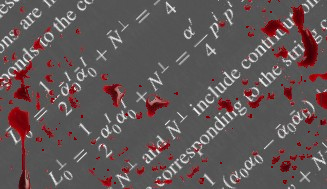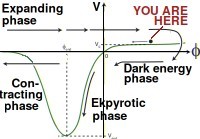 he universe, as every school child knows, started at the Big Bang: a gigantic
eruption of spacetime from a singularity that created all of space, time, matter,
and energy. The Big Bang explains cosmic expansion, and cosmic inflation explains
the relative abundance of the light elements and the unimaginable homogeneity of
the cosmic microwave background.
he universe, as every school child knows, started at the Big Bang: a gigantic
eruption of spacetime from a singularity that created all of space, time, matter,
and energy. The Big Bang explains cosmic expansion, and cosmic inflation explains
the relative abundance of the light elements and the unimaginable homogeneity of
the cosmic microwave background.
That is what everyone was taught. For years, famous scientist-celebrities have been trying to convince us that space and time started at the Big Bang. It was not an explosion in space; it was everywhere. Both time and space started at a single point and it is foolish and naive to ask what happened before. But there have always been problems with it: Doesn't this violate conservation of energy in a very big way? If change is something that happens in time, how could a Big Bang, possibly the biggest change ever, even happen?

A string
A new book titled Cosmology and String Theory by Horaţiu Năstase[1] shows that a revolution in thinking is taking place in cosmology, mainly as a result of string theory[2,3,4]. There are also many popular-style books on the subject, including Cycles of Time by Roger Penrose. String theory is not just mathematically complicated; it is protean and ever-changing. By the time you read this, its ideas may have been abandoned, resurrected, and been abandoned again. But what it is telling us is that despite what we've been told, it really does make sense to ask what happened before the Big Bang. Indeed, there may never have been a Big Bang or inflation at all. The universe may have always existed. String theory is telling us the universe may be eternal.
Cosmic inflation
Inflation as hypothesized by Alan Guth was a brilliant solution to several mysteries:
- Why is the cosmic microwave background, or CMBR, so smooth and isotropic? It is flat to 10 parts per million.
- Why is there so much entropy in the universe? Physicists calculate that entropy increased from 1063 at the time of Big Bang nucleosynthesis, which ended about twenty minutes after the BB, to 1088 today. Why so much?
- Why are there apparently no magnetic monopoles? The theory states that even the existence of a single magnetic monopole somewhere in the universe would mean that the charge of an electron is quantized. We are pretty sure electrons are quantized. So where are all the monopoles?
- Why is baryon asymmetry so small but not zero? Calculations show that the number of baryons and antibaryons must have originally been equal to one part in a billion. A universe filled with matter shouldn't exist at all.
In inflation, a scalar energy field called an inflaton field (𝜙) decays over time, causing spacetime to inflate by a factor of 1026 or so. When the potential V(𝜙) runs out of steam, so to speak, which happens after about 10−32 seconds, inflation stops. This is called slow-roll inflation, which means the potential V(𝜙) is spontaneously rolling down a potential energy gradient.
A field is a property that exists in every point of a region. A scalar field is a field in which the property does not have a preferred direction. Temperature is a scalar field and wind velocity is a vector field.
After inflation we get a period of reheating, where the mysterious inflaton particles decay into something else—some have suggested maybe Higgs bosons—and we get cooling and eventually a matter-dominated universe. Don't be fooled by all the equations that purport to describe it; nobody really knows how this works because nobody knows what spacetime is, and no one has ever detected an inflaton.
Branes and string theory

A string theory book after a tough study session
String theory tells us that 𝜙, now called a dilaton (sort of an anti-graviton), is the distance between two colossal five-dimensional things called branes moving in a six-dimensional space. When they collide we get a tremendous release of energy. One way to think of it is two giant bubbles passing through each other with our four-dimensional universe being the points on the surface where the bubbles touch. To match observations, the two branes have to be moving relative to each other and hit at an angle and one has to be an antibrane. Or instead of colliding maybe the brane moves in a bulk medium and merely generates the illusion of cosmic inflation. This is called “mirage cosmology.” Mathematically, these two scenarios are identical. In either case, the universe is vastly larger than we imagine and it may last forever.
In 2001 a paper came out [5] saying “motion through the extra dimensions of a gas of branes and antibranes can, under certain circumstances, produce an era of inflation as seen by observers trapped on a 3-brane, with the inflaton being the inter-brane separation.” In this theory, a tachyon field induces a cascade whereby higher dimension branes annihilate each other, eventually forming a 3-brane which we would call three-dimensional space. 3-branes are relatively stable because they have trouble finding each other in the (supposedly) 10-dimensional space. The energy caused by annihilation goes into reheating the universe.
There are numerous other competing models, including ekpyrotic, new ekpyrotic, and cyclic models, string gas models, and brane gas models.
Ekpyrotic and Cyclic Cosmology
The ekpyrotic theory is closely related to theories of cyclic cosmology. They're essentially more sophisticated versions of the Big Bounce theory, which postulated that the universe would eventually collapse under its own gravity to a singularity, which would then explode in a new Big Bang. The Big Bounce has been excluded by astronomical evidence, but the idea of a cyclic cosmology lives on. As with the brane collision theory, it hypothesizes that the universe is eternal.

Ekpyrotic cyclic universe model. The size of the universe is governed by a single parameter 𝜙. When 𝜙 increases, the universe expands. When it decreases, we see dark energy. Eventually the universe contracts catastrophically and then explodes in a new Big Bang. We are on the Dark Energy side of the energy diagram (redrawn from [6]).
As time goes on, V reaches a steady value (which we perceive as a cosmological constant) and then slowly decreases. When 𝜙 hits zero and goes minus, the universe goes through a sudden contracting phase (called an ekpyrotic phase) leading to a Big Bang and an expansion, and V(𝜙) becomes positive again. The entropy of the universe continuously increases from one cycle to the next, but so does the volume, so each cycle appears the same as the previous one.
Penrose has a similar theory he calls Conformal Cyclic Cosmology, or CCC. A conformal theory simply means that two different things are essentially the same except for a scale factor, called a conformal factor. In this case the two ‘things’ are the present universe and the newer, shinier, and cuter baby universe, which magically springs out of the old one.
One of the main characteristics of a universe is that its entropy increases over time. So to conserve entropy, the CCC requires the initial entropy to match the final entropy in the old universe. Getting rid of the entropy would be like stuffing billions of tons of Silly String back into a single can and having it happen spontaneously. Short of running time backwards, it is hard to imagine it happening.
Current thinking is that black holes, which have enormous entropy, will be the last remaining objects in our universe. Then they will evaporate, ultimately leaving only subatomic particles and photons. Conversely, at the Big Bang, entropy is supposed to be zero (or nearly zero). Thus, Penrose says we must accept huge entropy (i.e. information) losses in black holes.
As he recognizes, this would violate our physical laws as well. How that works is a detail that still needs to be worked out. But scientists have learned from experience that what Roger Penrose says should be taken seriously.
1. Năstase H (2019) Cosmology and String Theory Springer, 2019
2. Baumann D, McAllister L (2009). Advances in Inflation in String Theory arxiv0901.0265.pdf Annu. Rev. Nuc. Part. Sci. 2009 59
3. McAllister L, Silverstein E (2008). String Cosmology: A Review arxiv0710.2951v2.pdf [hep-th]
4. Baumann D, McAllister L (2009). Inflation and String Theory arxiv-1404.2601.pdf in Inflation and String Theory, Cambridge University Press
5. Burgess CP, Majumdar M, Nolte D, Quevedo F, Rajesh G, Zhang RJ (2001). The Inflationary Brane-Antibrane Universe arxiv: hepth-0105204v3.pdf
6. Lehners JL, Ekpyrotic and cyclic cosmology. arXiv:0806.1245v2 [astro-ph]
dec 23 2020, 4:53 am
